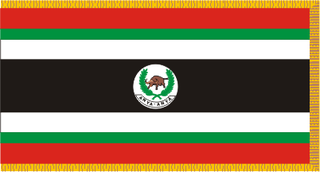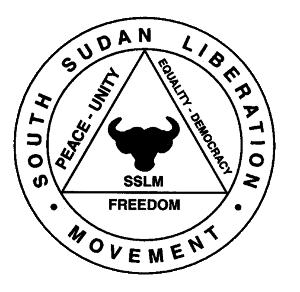 W
WThe Anyanya were a southern Sudanese separatist rebel army formed during the First Sudanese Civil War (1955–1972). A separate movement that rose during the Second Sudanese Civil War were, in turn, called Anyanya II. Anyanya means "snake venom" in the Madi language.
 W
WThe Azania Liberation Front (ALF) was an armed rebel faction established in 1965, during the First Sudanese Civil War, by exiled members of the Sudan African National Union (SANU). It was a part of the original South Sudan Liberation Movement, the first Sudanese secessionist movement. Its name was taken from the Greek Azania, the Greek designation for the lands of East Africa south of Nubia.
 W
WThe Beja Congress is a political group comprising several ethnic entities, most prominently the Beja, of the eastern region of Sudan. It was founded in 1957 by Dr. Taha Osman Bileya together with a group of Beja intellectuals, as a political platform for the politically and economically marginalized Beja people. According to the "Black Book", an analysis of Sudanese regional political representation published underground in the late 1990s by Darfur Islamist followers of Hassan al-Turabi, Eastern Sudan has been conspicuous since its independence for its political and economic marginalization. This part of Sudan had fewer ministers and representatives than other parts of the country in the civil and military branches of the central government, as well as having among the lowest rates of education and access to health services in the country.
 W
WThe Eastern Front is a coalition of rebel groups operating in eastern Sudan along the border with Eritrea, particularly the states of Red Sea and Kassala. The Eastern Front's Chairman is Musa Mohamed Ahmed. While the Sudan People's Liberation Army (SPLA) was the primary member of the Eastern Front, the SPLA was obliged to leave by the January 2005 Comprehensive Peace Agreement that ended the Second Sudanese Civil War. Their place was taken in February 2004 after the merger of the larger Beja Congress with the smaller Rashaida Free Lions, two tribal based groups of the Beja and Rashaida people, respectively. The Justice and Equality Movement (JEM), a rebel group from Darfur in the west, then joined.
 W
WThe Justice and Equality Movement is an opposition group in Sudan founded by Khalil Ibrahim. Gibril Ibrahim has led the group since January 2012 after the death of Khalil, his brother, in December 2011. JEM's political agenda includes issues such as: radical and comprehensive constitutional reform to grant Sudan's regions a greater share of power in ruling the country, the replacement of social injustice and political tyranny with justice and equality, and basic services for every Sudanese.
The Liberation and Justice Movement is a rebel group in the Darfur conflict in Sudan, led by Dr Tijani Sese. The Liberation and Justice Movement is an alliance of ten smaller Darfuri rebel organisations which formed a new grouping on 23 February 2010. On 20 March 2010, the Liberation and Justice Movement signed a cease-fire agreement with the Sudanese Government and agreed to talks that could lead to a final peace agreement. The Liberation and Justice Movement participated in the Doha peace negotiations held in December 2010 and in January 2011, its leader stated that the movement had accepted the core proposals of the Darfur peace document proposed by the joint-mediators. On 29 January 2011, the leaders of the Liberation and Justice Movement and of the rival Justice and Equality Movement issued a joint statement stating their commitment to the Doha negotiations and agreed to attend the Doha forum in February 2011. The Liberation and Justice Movement signed a new Darfur Peace Agreement with the Sudanese Government in July 2011; however, various factions of the group have merged with the Justice and Equality Movement.
 W
WThe Lord's Resistance Army (LRA), also known as the Lord's Resistance Movement, is a rebel group and heterodox Christian group which operates in northern Uganda, South Sudan, the Central African Republic, and the Democratic Republic of the Congo. Originally known as the United Holy Salvation Army and Uganda Christian Army/Movement, its stated goals include establishment of multi-party democracy, ruling Uganda according to the Ten Commandments, and Acholi nationalism.
 W
WThe Nuer White Army, sometimes decapitalised as the "white army", is a semi-official name for a militant organisation formed by the Nuer people of central and eastern Greater Upper Nile in modern-day South Sudan as early as 1991. According to the Small Arms Survey, it arose from the 1991 schism within the Sudan People's Liberation Movement/Army (SPLM/A) for the dual purpose of defending Nuer cattle herds from neighbouring groups and fighting in the Second Sudanese Civil War between the SPLM/A and the Sudanese government.
 W
WThe South Sudan Defence Forces (SSDF) was a militia in South Sudan during the Second Sudanese Civil War (1983-2005) in uneasy alliance with the Government of Sudan.
 W
WThe South Sudan Liberation Movement (SSLM) is an armed group that operates in the Upper Nile Region of South Sudan. The group's creation was announced in November 1999 by people of the Nuer ethnicity who were in both the rebel Sudan People's Liberation Army (SPLA) and the government-allied South Sudan Defence Forces (SSDF) gathered in Waat. The SSLM was declared to be unaligned in the Second Sudanese Civil War, then entering its sixteenth year. The name "South Sudan Liberation Movement" was decided upon the next year, borrowing from the earlier Southern Sudan Liberation Movement, which existed in the 1980s.
 W
WThe South Sudan People's Defence Forces (SSPDF), formerly the Sudan People's Liberation Army (SPLA), is the army of the Republic of South Sudan. The SPLA was founded as a guerrilla movement against the government of Sudan in 1983 and was a key participant of the Second Sudanese Civil War, led by John Garang. After Garang's death in 2005, Salva Kiir was named the SPLA's new Commander-in-Chief. As of 2010, the SPLA was divided into divisions of 10,000–14,000 soldiers.
 W
WThe SPLA-Nasir was a splinter faction of the Sudan People's Liberation Army (SPLA), a rebel group that fought in the Second Sudanese Civil War. Originally created as an attempt by the Nuer tribe to replace SPLA leader John Garang in August 1991, it gradually became coopted by the government. The break away of Riek Machar from SPLM/A resulted in Nuer ethnic group massacring Garang's ethnic Dinka from Bor in the Bor massacre in 1991. This split resulted in the 1994 National Convention of New Sudan in Chukudum.
 W
WThe Sudan People's Liberation Movement (SPLM) is a political party in South Sudan. It was initially founded as the political wing of the Sudan People's Liberation Army in 1983. On January 9, 2005 the SPLA, SPLM and Government of Sudan signed the Comprehensive Peace Agreement, ending the civil war. SPLM then obtained representation in the Government of Sudan, and was the main constituent of the Government of the then semi-autonomous Southern Sudan. When South Sudan became a sovereign state on 9 July 2011, SPLM became the ruling party of the new republic. SPLM branches in Sudan separated themselves from SPLM, forming the Sudan People's Liberation Movement-North. Further factionalism appeared as a result of the 2013-2014 South Sudanese Civil War, with President Salva Kiir leading the SPLM-Juba and former Vice President Riek Machar leading the Sudan People's Liberation Movement-in-Opposition.
 W
WSudan People's Liberation Movement – North, or SPLM–N, is a political party and militant organisation in the Republic of Sudan, based in the states of Blue Nile and South Kordofan. As of 2017, its two factions, SPLM-N (Agar) and SPLM-N (al-Hilu) were engaged in fighting each other and against the government of Sudan.
 W
WThe Sudan Revolutionary Front, or the Sudanese Revolutionary Front (SRF), is an alliance between Sudanese factions that was created in opposition to the government of President Omar al-Bashir. It was declared on 12 November 2011, following several months of support by Darfuri rebel groups for the Sudan People's Liberation Movement-North in the conflict in South Kordofan and Blue Nile.